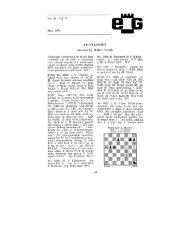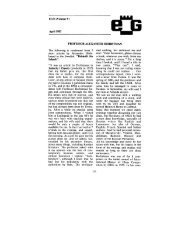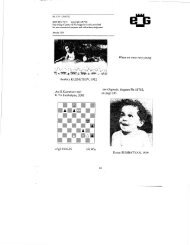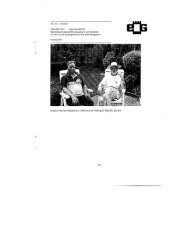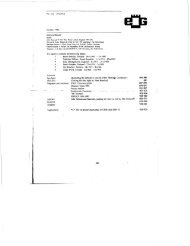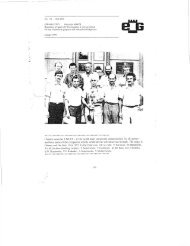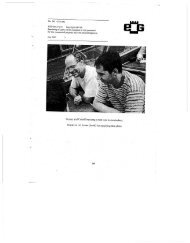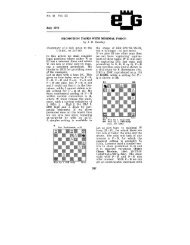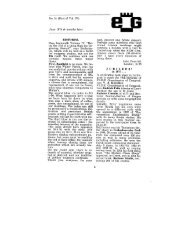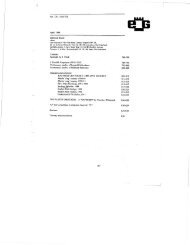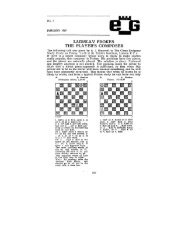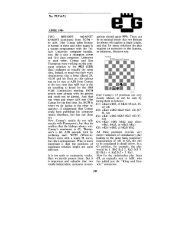You also want an ePaper? Increase the reach of your titles
YUMPU automatically turns print PDFs into web optimized ePapers that Google loves.
L. F. J. Prokop=3-4th Prize,Shakhmatny Listok, 1925Draw 3-f51. Bh4/i Bxh4 2. Rxg4, with two Unes:2. . . Bf2 3. Rxg2 62 4. Rg5 dlQ 5. Rd5f.2. . . Bfl 3. Rxh4 d2| 4. Ka5 dlQ 5. Rd4f.i) 1. Rg8f? Ke7 2. Bel Bf3 3. Ka5 Kf74. Rb8 Bg5 5. Rb2 Bf4 6. Kb4 Be2 7. Kb3g3 8. Rbl g2 9. Bf2 Bd2 10. Kc2 Ke6wins.Subsequently Prokop concentratedmostly on selfmates and in1940 published a collection of his100 best problems in this field,excelling the hitherto leadingCzech composer Knotek in ideasand precision of construction.For a "minority" citizen to havea book published in Czech landsunder German rule was somewhatan exception, but in 1943 Prokopeven followed up with an enlargededition of his studies: "212Endspielstudien", published inGerman.By environment and by chess tradition,Prokop was native to thecore but politically a right-wingerand educationally versatile. Heseemed to adjust well and unobtrusivelyto the powers that be,and as the editor of one of the indigenousCzech-language paperspermitted to appear during theWar, Prokop made no waves (sic).His book of studies contains onediagram prominently dedicatedto the German Chess Czar E. Postof Berlin.No wonder that after the liberationProkop was under a cloud, ina country freed from domination,and with a new social alignment.J. Fritz' book on the endgamestudy (published in 1951) lists allprominent Czech study composersand pointedly omits the "nonperson"Prokop. Perhaps as a futureblessing, Prokop thus waspolitically neutralized. But withchess still a sideline in human affairs,he was subsequently permittedto function as the chessinstructor in Prague's Central Institutefor Youth and to continueputting his phenomenal chess versatilityand eruditon to productiveuse. In 1968, in the aftermath ofthe political thaw, the Institutepublished Prokop's "Kouzlo SachovehoDiagramu - Zauber desSchachdiagramms", a bilingualcollection with explanations andB. F. J. Prokop3rd Prize, International'Fizkultura' Tourney,Moscow 1925(Diagram 26 in FJP'sZauber )Draw 44-5"Perpetual stalemate. Thus the studywas defined in the USSR, but it is appropriateto call it a treadmill. Tryingto destroy the stalemate net, Bl keepschecking in a rhythmical circle whereaswK keeps abreast in the same direction.The study is cited in almost all Sovietbreviaries as a shining example of beautyin chess" (Prokop).1. Sf8t Kh8 2. Sg6t Qxg6 (Kh7? f8Smate) 3. f8Qt Kh7 4. Bbl Bc3f/i 5. Ke3Bd4f 6. Kd2/ii Be3f/iii 7. Kc3 Bd2| 8.Kd4, or 7. .. Bd4f 8. Kd2, draw,i) 4. .. Qxbl 5. Qf5f Qxf5 stalemate. If4. .. Be3f 5. Kc3. At any point fromnow on bB can check wK on two squares,but the same stalemate positionsarise in either case, in the end.ii) Whenever WK takes bB. .. Qxblwould win.iii) 6. .. Qxbl 7. Qh8t Kg6 8. Qh7f (ina rare error Prokop gives 7. Qxg7|, but7. .. Bxg7 wins).182



